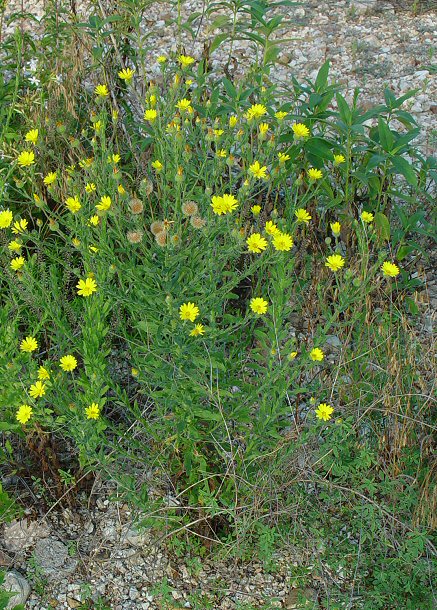Bradburia pilosa (Nutt.) Semple
Soft Goldenaster

Native
CC = 3
CW = 5
MOC = 35
© DETenaglia
Bradburia pilosa (Nutt.) SempleSoft Goldenaster | |
 |
Native CC = 3 CW = 5 MOC = 35 |
© DETenaglia |
|
Family - Asteraceae/Astereae Habit - Taprooted annual forb. Stems - Ascending to erect, to 80 cm, with ascending branches in upper portion, with fine, longitudinal lines, moderately to densely pubescent with longer and shorter, fine, bent or curled hairs, many of the shorter hairs gland-tipped.
Leaves - Basal leaves usually withered by flowering time, oblanceolate, the margins usually with 2 to several pairs of teeth. Stem leaves numerous, alternate, sessile, 1-6 cm long, oblanceolate to narrowly oblong-oblanceolate or linear, rounded to bluntly or sharply pointed at the tip, more or less tapered to a slightly expanded but not strongly clasping base, the margins entire or few-toothed toward the tip, the surfaces and especially the margins moderately to densely pubescent with longer and shorter, fine, bent or curled hairs, many of the shorter hairs gland-tipped.
Inflorescence - Flat-topped or shallowly convex panicles, the heads solitary or in small, loose clusters toward the branch tips, the branch tips and stalks short to relatively long, with usually several leaflike, linear bracts 0.5-1.5 cm long. Heads - Radiate, not resinous. Involucre 6-10 mm long, cup-shaped. Involucral bracts in 3 or 4 unequal, overlapping series, narrowly lanceolate to linear, the slender tip ascending and often brownish- or purplish-tinged, the outer surface moderately hairy, at least some of the shorter hairs gland-tipped. Receptacle flat or slightly convex.
Florets - Ray florets 13-25, fertile, pistillate, the ligule 6-12 mm long, yellow, not persistent at fruiting. Corolla tubes pubescent. Disc florets 25-60, perfect, the corolla 4.5-6.0 mm long, yellow, not persistent at fruiting. Pappus of the ray and disc florets similar, a low crown of several shorter, white to off-white scales 0.5-1.0 mm long and numerous longer, finely barbed bristles 4-6 mm long, these usually white when young but often turning straw-colored to light orangish brown as the fruits mature. Stamens 5, fused to base of corolla tube. Anthers yellow. Style bifurcate. Stigmas barbellate.
Fruits - Achenes 1.7-2.5 mm long, more or less wedge-shaped to slightly obovoid, often slightly flattened, finely 10-nerved, the nerves sometimes difficult to observe, the surface moderately pubescent with fine, appressed, silvery hairs, light tan to brown.
Flowering - June - October. Habitat - Upland prairies, sand prairies, glades, savannas, streambanks, old fields, railroads, roadsides. Origin - Native to the U.S. Lookalikes - Heterotheca camporum, Heterotheca subaxillaris, and more broadly, other members of the aster family. Other info. - This species can be found in the southern third of Missouri. Its U.S. range is southern, largely restricted to a few states centered roughly at the intersection of Arkansas, Oklahoma, and Texas. The plant is easy to ID in the field. The conspicuously hairy stems and bright golden flowers are good characteristics to look for. The species is sometimes used in native landscaping and deserves more attention in cultivation. Photographs taken at Logan Creek, Reynolds County, MO., 7-17-03 (DETenaglia); also at Arrowhead State Park, OK, 7-25-2016, and Bona Glade Natural Area, Dade County, MO, 8-5-2024 (SRTurner). |